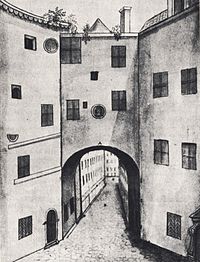
The history of Stockholm, capital of Sweden, for many centuries coincided with the development of what is today known as Gamla stan, the Stockholm Old Town. Stockholm's raison d'être always was to be the Swedish capital and by far the largest city in the country.

Gamla stan, until 1980 officially Staden mellan broarna, is the old town of Stockholm, Sweden. Gamla stan consists primarily of the island Stadsholmen. Officially, but not colloquially, Gamla stan includes the surrounding islets Riddarholmen, Helgeandsholmen and Strömsborg. It has a population of approximately 3,000.
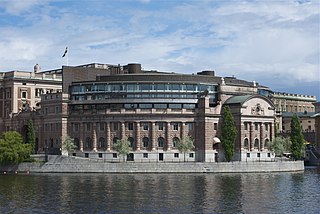
Helgeandsholmen is a small island in central Stockholm, Sweden. It is located north of Stadsholmen, and east of Strömsborg, with which, together with Riddarholmen, it forms Gamla stan, the old town of Stockholm. Helgeandsholmen contains the Riksdag Building and the Museum of Medieval Stockholm, and is connected to neighbouring islands through three bridges: Riksbron, Stallbron, and Norrbro.

The City of Stockholm is situated on fourteen islands and on the banks to the archipelago where Lake Mälaren meets the Baltic Sea. The city centre is virtually situated on the water.

Stockholm City Hall is the seat of Stockholm Municipality in Stockholm, Sweden. It stands on the eastern tip of Kungsholmen island, next to Riddarfjärden's northern shore and facing the islands of Riddarholmen and Södermalm. It houses offices and conference rooms as well as ceremonial halls. It is the venue of the Nobel Prize banquet and is one of Stockholm's major tourist attractions.

Stortorget is a public square in Gamla Stan, the old town in central Stockholm, Sweden. It is the oldest square in Stockholm, the historical centre on which the medieval urban conglomeration gradually came into being. Today, the square is frequented by tens of thousands of tourists annually, and is occasionally the scene for demonstrations and performances. It is traditionally renowned for its annual Christmas market offering traditional handicrafts and food.
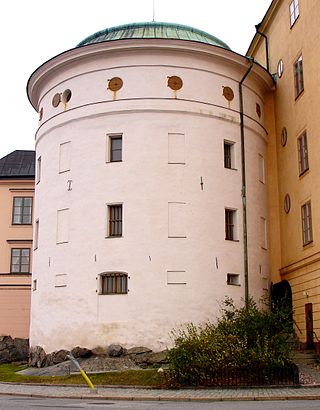
Birger Jarls torn is a defensive tower on the northwest corner of Riddarholmen, an islet in Gamla Stan, the old town of Stockholm.

Nyköping Castle is a Medieval castle, located in Nyköping, from the Birger Jarl era, partly in ruins, mostly known for the Nyköping Banquet which took place here in 1317.

Norrbro is an arch bridge over Norrström in central Stockholm. It extends north from the northern front of the Royal Palace passing over Helgeandsholmen in front of the Riksdag building, and from there over to Gustav Adolfs torg. Norrbro was designed by the city architect Erik Palmstedt (1741–1803) in a neoclassical style.
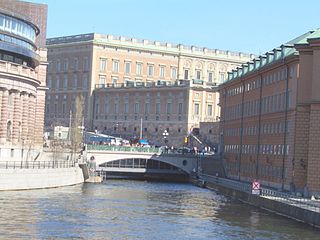
Stallbron is an arch bridge located in Gamla stan, the old town in central Stockholm, Sweden. Stretching some 20 meters over Stallkanalen it connects Riksgatan passing through the Parliament Building on Helgeandsholmen to the square Mynttorget on Stadsholmen from where Västerlånggatan extends it further south.

Västerlånggatan is a street in Gamla stan, the old town of Stockholm, Sweden. Stretching southward between the squares Mynttorget and Järntorget, it follows the course of the city's now demolished 13th-century defensive wall.

Österlånggatan is a street in Gamla stan, the old town of Stockholm, Sweden. Stretching southward from Slottsbacken to Järntorget, it forms a parallel street to Baggensgatan and Skeppsbron. Major sights include the statue of Saint George and the Dragon on Köpmanbrinken and the restaurant Den Gyldene Freden on number 51, established in 1722 and mentioned in Guinness Book of Records as one of the oldest with an unaltered interior.

Tyska Brinken is a street in Gamla stan, the old town in central Stockholm, Sweden. Extending Kindstugatan past the German Church down to the square Mälartorget, it is crossed by Skomakargatan, Prästgatan, Västerlånggatan, Stora Nygatan, Lilla Nygatan, and Munkbrogatan, while forming a parallel street to Schönfeldts Gränd and Lejonstedts Gränd.

Vädersolstavlan is an oil-on-panel painting depicting a halo display, an atmospheric optical phenomenon, observed over Stockholm on 20 April 1535. It is named after the sun dogs appearing on the upper right part of the painting. While chiefly noted for being the oldest depiction of Stockholm in colour, it is arguably also the oldest Swedish landscape painting and the oldest depiction of sun dogs.
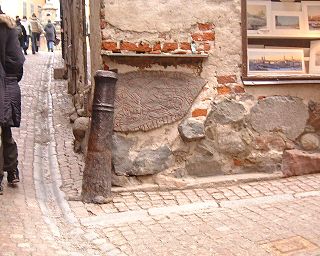
The prehistory of Stockholm is the continuous development and series of events that made the mouth of Lake Mälaren strategically important; a location which by the mid 13th century had become the centre of the newly consolidated Swedish kingdom. The origin of Stockholm pre-dates its written history, and several mythological stories and modern myths have attempted to explain both its emergence and its name.

The architecture of Stockholm has a history that dates back to the 13th century, possibly even earlier. According to some sources, there might have been a simple defense structure, perhaps a small castle, on the northeast part of the island Stadsholmen. Buildings in Stockholm are characterized by their unique location between Lake Mälaren and the Baltic Sea. The Hanseatic League during the great period of industrialization saw a strong desire to modernize the city.

Vårfruberga Abbey, previously Fogdö Abbey was a Cistercian monastery of nuns from the 12th century until 1527, situated 1 mile north-west of Strängnäs on the Fogdö peninsula in Lake Mälaren, formerly a parish, in Södermanland, Sweden.

Stegeborg Castle is a ruined castle in St Anna parish, Söderköping, Östergötland, located on an island in a narrow sound at the bay of Slätbaken.

The Black Friars' Monastery, Svartbrödraklostret, also called the convent of Stockholm, was a Dominican monastery on the island of Stadsholmen in central Stockholm, founded by King Magnus IV in 1336 when he donated a plot of land located in the southern part of Stadsholmen to the Black Friars. By order of Gustav Vasa the monastery was demolished in 1547, but some of the vaults are still preserved and can be visited. Today Svartmangatan, which led down to the monastery, is still reminiscent of the Black Friars' era.

The following outline is provided as an overview of and topical guide to Stockholm:

